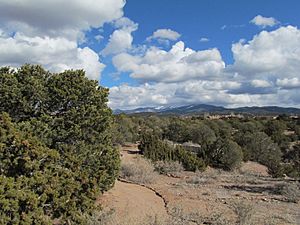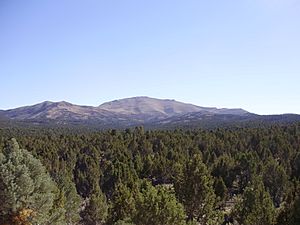Pinyon–juniper woodland facts for kids
Pinyon–juniper woodlands are special types of forests found in the western United States. They grow in higher places, often where deserts meet mountains. These woodlands are mostly made up of short, bushy evergreen trees called junipers and pinyon pines. Sometimes you'll see just pinyon pines, or just junipers, or a mix of both. These trees can grow from less than 10 meters (about 33 feet) to 15 meters (about 49 feet) tall.
Contents
What is a Pinyon–Juniper Woodland?
Even though these woodlands are often found near deserts, they are not true deserts. This is because pinyon trees need at least 12 inches of rain each year to grow. Smaller junipers can survive with about 9 inches of rain. Since deserts usually get less than 10 inches of rain and have very little plant life, pinyon trees cannot live there.
Areas that get more than 10 inches of rain are called "steppes." Pinyon and juniper trees prefer to grow in these steppes, especially where the soil is not very deep. Grasslands, on the other hand, usually grow in areas with deeper soil.
Where Do Pinyon–Juniper Woodlands Grow?
Pinyon–juniper woodlands are found across a large part of the western United States. Their range stretches from New Mexico all the way to the eastern Sierra Nevada mountains. You can also find them in the Colorado Plateau, the Great Basin, and in the higher parts of the Mojave Desert. These woodlands reach as far south as the Mogollon Rim and as far north as the Snake River Plain.
Pinyon–Juniper Woodlands in Arizona and New Mexico

In northern Arizona and New Mexico, pinyon–juniper woodlands are one of the most common types of conifer (cone-bearing) forests.
In Arizona, you can find different types of junipers like Juniperus arizonica, Juniperus californica, Juniperus deppeana, Juniperus monosperma, Juniperus osteosperma, and Juniperus scopulorum at higher elevations. The pinyon pines include Pinus monophylla (found below the Colorado Plateau) and Pinus edulis (found on the Colorado Plateau). Many types of oak trees also grow here, such as Quercus turbinella, Quercus gambelii, Quercus grisea, Quercus arizonica, and Quercus emoryi. In southern Arizona, Pinus discolor, Juniperus deppeana, and Pinus leiophylla grow with many oak species.
Pinyon–Juniper Woodlands in Utah
These woodlands cover a large part of Utah and the Canyonlands area. Here, you'll often see singleleaf ash (Fraxinus anomala) and Utah serviceberry (Amelanchier utahensis) growing alongside pinyon pines and Utah junipers. In this region, these plant communities usually grow on rocky soils or cracked bedrock.
Pinyon–Juniper Woodlands in the Mojave Desert
In the areas next to the Mojave Desert, these woodlands grow where they get 12 to 20 inches of rain each year. They are found at elevations between 4,500 and 8,000 feet. Other plants that grow with them include bitterbrush (Purshia glandulosa), Apache plume (Fallugia paradoxa), desert sagebrush (Artemisia tridentata), green ephedra (Ephedra viridis), mountain mahoganies (Cercocarpus spp.), and buckwheats (Eriogonum spp.). In the Mojave, pinyon–juniper woodlands are generally found above the Joshua Tree woodlands, as they need more rain.
Pinyon–Juniper Woodlands in the Sierra Nevada
In the eastern Sierra Nevada mountains, these woodlands grow at different elevations depending on the area. In the north, they are found between 4,000 and 5,500 feet. In the south, they grow between 5,000 and 8,000 feet. Pinyon–juniper woodlands need 12 to 20 inches of rain each year. This means they usually grow above the sagebrush scrub areas, which can survive on only about 7 inches of rain per year. They are found below the alpine zone, which is the very cold, high-elevation area. Often, you'll find sagebrush (Artemisia tridentata) and other plants growing beneath the trees. Sometimes, Jeffrey Pine (Pinus jeffreyi) also grows here, with sagebrush or rabbitbrush (Ericameria spp.) as an understory.
Life Cycle and Challenges
Pinyon pines grow very slowly. It can take almost 100 years for them to reach 12 meters (about 39 feet) tall! They only start to grow cones after about 35 years. They produce a lot of seeds (called "seed masting") every 5 to 7 years throughout their lives.
This woodland habitat is not well-suited for large, destructive fires. There usually isn't enough fuel (dead plants) to keep a big fire going. However, many of the smaller plants that grow with the trees are very sensitive to wildfires. These smaller plants are important because pinyon and juniper trees often need them to help new seedlings grow.
Sometimes, people use controlled fires to manage the land or clear space for new plants. But these controlled burns can actually harm the woodland by destroying the seeds in the soil. They can also make it easier for invasive grasses, like cheatgrass, to grow. Cheatgrass is a big problem because it burns very easily, leading to more frequent and intense wildfires that can change the woodland forever.
Variations in elevation can cause junipers and pinyon trees to grow together, often around 5,000 feet. However, some juniper species, especially the Western juniper, can become invasive. They can take over the smaller plants and affect wildlife. When junipers grow too much, they can also lead to more soil erosion and use up too much groundwater, which harms the ecosystem.
Main Tree Species
- Junipers, common types:
- Pinyon pines, common types:
- Pinus edulis (Colorado pinyon or two-needle pinyon)
- Pinus monophylla (single-leaf pinyon)


